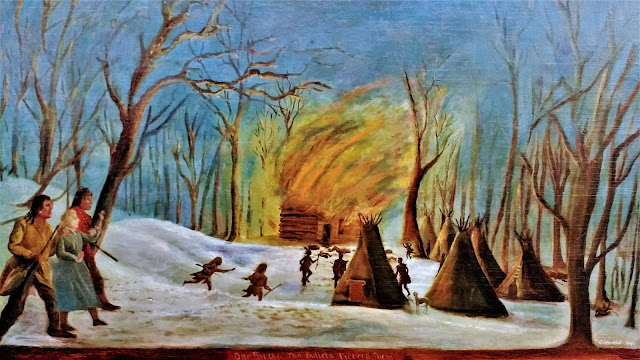That left her alone with three small children. Two were her brothers, the other belonged to an older married sister who happened to be away. The Wahpakutes grabbed the children, dragged them outside, and clubbed all of them to death.
After ransacking the house, and taking whatever they thought might be serviceable, such as provisions, bedding, arms and ammunition; and after the bloody scalping knife had done its terrible work; I was dragged from the never-to-be-forgotten scene. No language can ever suggest, much less adequately portray, my feelings as I passed that door.What happened at the Gardner cabin was the first act of a string of atrocities along the shore of lake shore, a string that, a day later, extended into the town we know today as Jackson, Minnesota. The night before that attack, Abbie remembers, while captive, seeing the same warriors, her family’s killers, dress once again for battle. They might have killed all the residents had there not been a warning. Even so, Inkpaduta’s men plundered what they could and killed seven more settlers, including another eight-year-old boy. To say those victims were murdered unmercifully seems redundant, but consider it understatement.
In all, Inkpaduta’s band killed as many as 40 settlers in the three-day rampage and took four women captives, including young Abbie Gardner.
Inkpaduta
Any telling of the story cannot deny that the Wahpekutes had cause, as their descendants will say; the existence of the tribe and their freedom were at stake. From an indigenous point of view, what Inkpaduta accomplished was what they had set out to do: clear the area of white settlers, the illegal immigrants. That, they did—for a time.
Even before the massacre, Inkpaduta, the “chief” of the Wahpekute band, was considered dark as sin itself by white settlers—with significant cause. He’d been committed to the neighborhood of the Little Sioux River, where he had managed to make few friends among the settlers. But the level of hideous carnage the band had reached that late winter day was new and entirely beyond imagination.
Like several other Sioux headmen, Inkpaduta refused to buy into the treaty/reservation system, the white man’s view of how “Indians” should live. He despised the enforced settlement created by treaties. The Minnesota State Historical Society describes the Treaty of 1851, signed just north of St. Peter, Minnesota, just six years previous, this way:
At Traverse des Sioux, the Sisseton and Wahpeton bands of the Dakota ceded 21 million acres. At Mendota, the Mdewakanton and Wahpekute bands ceded about 14 million acres. The combined payment was about $3,075,000. Most of this money was to be paid in the form of annuities. At Traverse des Sioux, Dakota leaders signed—some later said they were tricked into signing—the infamous “Traders’ Paper.” This agreement turned over most of the Dakotas’ cash payments to their mixed-blood relatives and to traders, who had allowed debts to mount over the years in expectation of tapping into the flow of the government’s “Indian money.”
Signing the treaty meant being forced to live and stay within the boundaries of a territory twenty miles wide along the Minnesota River. Buffalo hunts west of the Missouri River kept people from hunger for some time; more than that, however, the hunt had become a ritual with significant cultural and religious significance. Not being able to leave the reservation meant the death of a way of life. Inkpaduta was unwilling to cede that to the Great Father in Washington or the settlers swarming into a region they’d always considered free. Moreover, annuities were frequently late; some never came. Some were disgusting.
Inkpaduta had lost a friend and blood relative brutally murdered along with his wife and children, all of them killed by a white man, a much-hated liquor peddler. After the murders, that man had gone farther west to avoid prosecution. When, later, Inkpaduta attempted to get justice from white courts, he came away claiming he’d received nothing but indifference.
That the Waupekutes had cause to fight the new settlers is understandable: white people had no right to take land that had always been theirs. But the Wahpakutes’ brutality left pioneer families throughout the region repulsed and fearful and therefore vigilant. For hundreds of miles in every direction, new white settlers left their farms and circled up behind quickly constructed walls to escape the carnage they assumed was coming.

______________________
Monday: Abbie's telling of her nearly month-long captivity at the hands of Inkpaduta's Santee band.


No comments:
Post a Comment